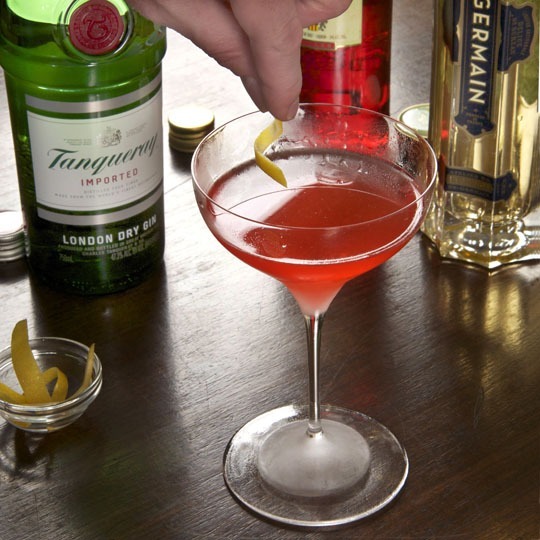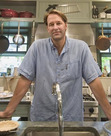Michael Ruhlman's Blog, page 31
January 21, 2014
The Importance of Family Meal
A post-dinner reenactment of the crime now known as the “Rack of Lamb with Lettuce-Butter Sauce” debacle. Photo by iPhone.
For the past several years my cousin Rob has brought me and his band of merry sailors to race in the Key West Regatta. I cook dinner for about 20 every night—sailors, spouses, itinerant friends, and other marauders who haunt the waterfront by day.
What I do, basically, is what one cook or another at restaurants throughout the country has to do daily: Feed the staff with what’s on hand. Happily, I don’t have to then work the line all night, and then clean my station, and then store the leftover food. As if by magic, a half hour after dinner, someone has made the kitchen spotless. But it did get me thinking about family meal (I’ll get to the lamb later).
It was partly on my mind after I read the superb chef-writer Gabrielle Hamilton’s essay on her ordering takeout for the staff at Prune and the abject humiliation she felt as a result. It’s a great story any cook will understand.
But it also brought me back to the long days I spent with Thomas Keller, talking about his career. He started as a family meal cook. He was hanging out on the beach in Narragansett, Rhode Island, an itinerant cook at the time who didn’t know much about cooking. A properly trained master chef from France, Roland Henin, asked young Tom if he wanted a job. “I need somebody to cook staff meal, interested?”
He was. And so he began cooking for the brigade of roughly fifty chefs who cooked at The Dunes Club resort. “It’s where I learned how to cook a green vegetable,” he told me long ago. And it’s also, partly, where he developed his love of French classics, as Henin was French and taught him those things as well—big braises like Lamb Navarin that one could do for a lot of people.
And that’s what I do here. Nothing fancy, just simple dishes that are easy to do for a lot of people. Plus, a lot of these guys (although none of the women, interestingly) love to cook, and so they help. Jim and Doug and Jeff are happy to be out on the grill taking care of the strip steaks or racks of lamb while I finish the veg, starch, and salad.
Too much help, though, can be frustrating. Russ Kellythorne had been fixated on a tater tot recipe he saw at Food52.com, talking about it on the plane, talking about it every day, When could he do his tater tots? I said he could do it for steak night. “But,” I said, “Are you sure? You do realize this is the potato course for 20 people, so that means you have to make about 100 good-sized tots, minimum.” He thought about it and, the morning in question, said, “I can do it.”
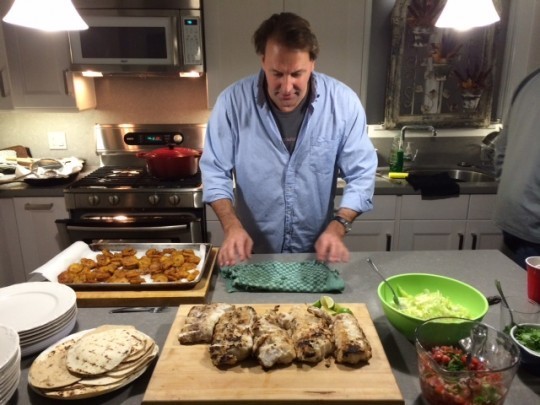
Spreading out family meal at the Key West house: grilled grouper tacos and tostones.
And at 6 pm that night we had a bucket of shredded undercooked potatoes. Russ had failed to underestimate not the quantity of potatoes but the oven power required to get this job done. (I needed the oven too, so part of his failure was due to my being cranky and wanting his fucking tater tots out of my fucking oven so I could reheat the twice-baked potatoes I had made earlier in case the tater tots didn’t happen.) Russ fried up his failure the next day with eggs and said they were delicious, but as any cook who has failed miserably knows, specific defeats will never be forgotten. Russ will take the memory to his grave. We’ve all been there.
And last night, Jim Sminchak, who is an ace in the kitchen, a really good cook, captain of the grill, and who also makes a killer habanero salsa for our snacks … well, I was finishing my gorgeous lamb racks in the oven and immersed in the last-minute hustle to get it all spread out, the rice pilaf, the raw zucchini salad, etc. As I was pulling the lamb from the oven, for which I had lovingly made a garlic-rosemary butter sauce, Jim took it upon himself to dress the green salad. But that stuff in the blender that looked to him like Caesar dressing was, in fact, my butter sauce for the lamb.
Doug Moose, watching, said, “I don’t think you should do that, Jim.” Which is pretty much daring Jim to do it—that’s how they work. “Why not?” he asked, just as I turned to see him pouring the last drops of my garlic-rosemary butter sauce onto the salad. All I could say was, “You are kidding me!”
So, there it was, Rack of Lamb with Lettuce-Butter sauce. We all have our tater tot moments.
But it made me think of family, and what a delight it is cook with a band of great people and share a meal together night after night. At least for me, it is the anchor of the day—and often the very best part of the day.
And it made me think of what Keller said about the importance of family meal for an aspiring chef. It’s staff meal. It doesn’t have to be perfect, it just has to get everyone fed. But, if a young cook can be passionate about family meal, can have intense desire to serve a really great meal to staff, “then,” Keller said, “he can be a chef.” Pause. “Maybe.” Staff meal. That’s where Tom Keller started being Thomas Keller.
Other links you may like:
My past post on How to Cook for Sixteen (and Not Stress).
Family meals cookbooks: The Family Meal, Family Table, and Lidia’s Italy in America.
Ad Hoc at Home, a true family meal book.
© 2014 Michael Ruhlman. Photo © 2014 Donna Turner Ruhlman. All rights reserved.
January 17, 2014
Friday Cocktail Hour: The Bitter Elder
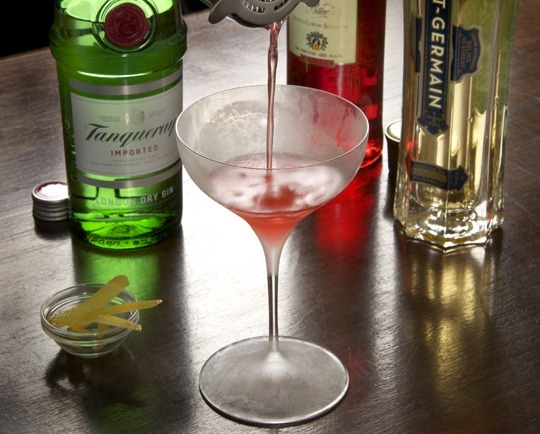
The Bitter Elder. Photo by Donna Turner Ruhlman.
It’s race week here in Key West, but my thoughts are with Donna in chilly Cleveland. It’s winter when I most crave bitters in a cocktail. Happily a suggestion on Twitter brought up a new cocktail for me, the Bitter Elder, and before I departed for southern climes, we gave it a go. The cocktail, which balances the bitterness of Campari with the sweet elderberry flavors of the liqueur, makes for a splendid libation, especially for those in the cold grays of the north.
I salute you from the southernmost and wish you a happy Friday Cocktail Hour.
The Bitter Elder
1.5 ounces gin
0.5 ounces Campari
0.5 ounces St. Germain
0.5 ounces lemon juice
Twist of lemon
Stir the liquids with ice in a shaker and pour into a chilled coupe. Garnish with a twist.
Other links you may like:
My past cocktails: the Rusty Nail, the Sawyer, and the Hasty Negroni.
Saveur covers the history of Campari and what makes it bitter.
A recipe for a Campari orange passion cocktail.
What else you can do with a bottle of St. Germain.
© 2014 Michael Ruhlman. Photo © 2014 Donna Turner Ruhlman. All rights reserved.
January 15, 2014
Key West Bound
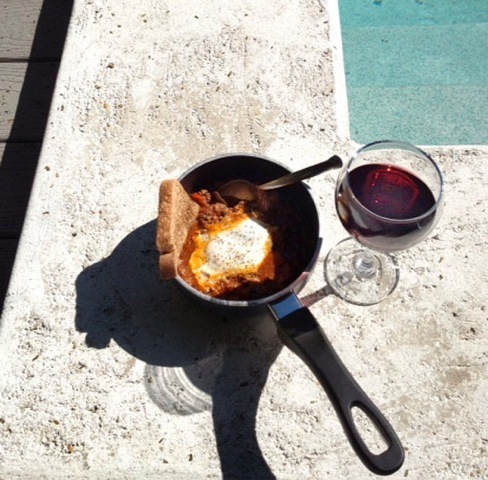
Poolside Key West Lunch: leftover Picadillo, egg, toast wine. My iPhoto
I’m headed south today for my annual boondoggle, cooking for my cousin and his sailing crew at the annual regatta there, ten days reserved solely for personal writing, reading, and cooking (and occasional carousing—the boys are pretty persuasive in the post-dinner hours). Dinner for twenty every night, and this year a new baby girl has been welcomed to the sailing family. Dinners will certainly feature some of the beloved standbys—Carolina BBQ, steaks, lobster. Many requested duck confit (I buy them from D’Artagnan; they’re fabulous and easy on the cook).
I usually do a huge shopping run the first day and start with six or seven chickens, breaking them down first thing so that I have stock, schmaltz, cracklins to flavor the food all week, and chicken for grilling (jerked last year). Though a cold front is moving through, so maybe a really good Bolognese and Caesar salad for the first night. It was suggested that I make bacon-wrapped fried chicken, and I just might give this one a go.
This is cooking for a big, hungry group, so it’s vats of food rather than petite, precise, à la minute meals. Vats of grits with sous vide eggs, hoppin’ john, black beans and rice.
For those who cook for big groups, I would love to hear what your go-to dishes are, especially the sides. Seriously, I’m looking for ideas! The main protein is easy—I have trouble with original sides.
© 2014 Michael Ruhlman. Photo © 2014Donna Turner Ruhlman. All rights reserved.
January 13, 2014
The Cleanest Hands
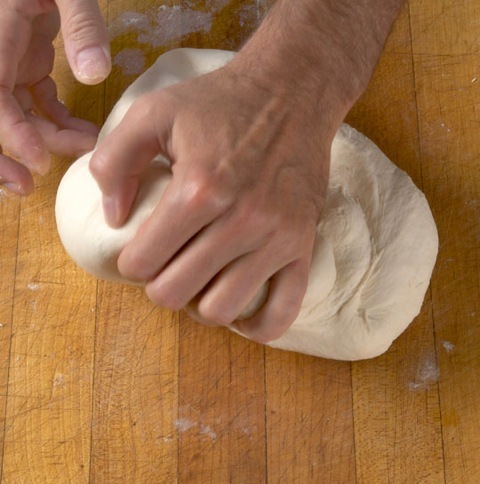
Using your hands is, um, essential to making food.
Photo by Donna Turner Ruhlman.
I remember cooking for my dear Uncle Jon at my dad’s house, and after sticking my finger into a simmering pot of sauce to taste it, he looked at me as if I’d just spit into the food. When I confirmed that he was indeed concerned about germs, I was astonished.
He seemed to have no idea that any bacteria on my finger would be killed by the heat (billions on the food and in the pot probably had been) and that my hands were the cleanest in the kitchen because, as I was cooking, I was continually washing them. (Please no comments from ID docs telling me about heat-resistant toxins; I’m not picking my nose and sticking it in food.) Yes, the cleanest hands in the kitchen.
I was alerted to the new California law requiring more use of gloves by cooks (for any “ready-to-eat” food) no matter the venue. Now, I suppose if you eat in a seriously skanky-ass food joint—smells bad, there’s no toilet paper in the john—you might want the guy putting together your BLT to have gloves on. But at any busy restaurant, my experience has been that the cooks’ hands are the cleanest in the place. You’re more likely to pick up germs from the waiter’s hand that sets your plate before you—but you don’t hear the legislators clamoring for this.
Yes, this California law is more of America’s ridiculous germ paranoia, and it makes me nuts. Especially as the people making the laws are likely the most ignorant of any people actually qualified to be judging the situation. Who would you trust on this issue—a tableful of bureaucrats in suits or a gathering of talented chefs who have been in the business for twenty years?
The chefs think, for the most part, that the law is not only silly, but it makes their work harder and is arguably less sanitary, as a cook is less likely to wash gloved hands, especially during a busy service.
So this law is in fact encouraging the very problem it strives to prevent. God, I’m glad I’m not governed by California—what a bunch of knuckleheads when it comes to food! Why don’t you people actually try to know what the fuck you’re talking about before legislating? Jesus.
Happily, I don’t live there and so can use this law to talk about something important: the pleasures of touching food. Thomas Keller loves to make pasta, in large part because the dough is so soft and supple on the fingers, such a pleasure to touch. The late Jean-Louis Palladin loved food so much he would get very close to it, to a piece of tuna belly, say, and stroke it lovingly. Our friend Susie Heller told me, “I wish I had a boyfriend who touched me the way Jean-Louis touches food!”
Yes, touching food is one of the great pleasures of cooking. Separating eggs, making meatballs, pasta, bread, swooping out a finger-load of sweet whipped cream and delivering it straight to the tongue (and then washing the hand!). Take the time to appreciate the texture and tone of the food you’re cooking and eating. It’s part of the fun of cooking.
Yes, Donna still gets annoyed when I reach across the table and jab my finger into her steak to make sure I’ve cooked it right (“Michael, get your hands out of my food!”), so I’ve stopped.
But if there’s one good thing about the debate over this California law, it’s a chance to call attention to the great pleasures of touching the food that you’re cooking with bare hands.
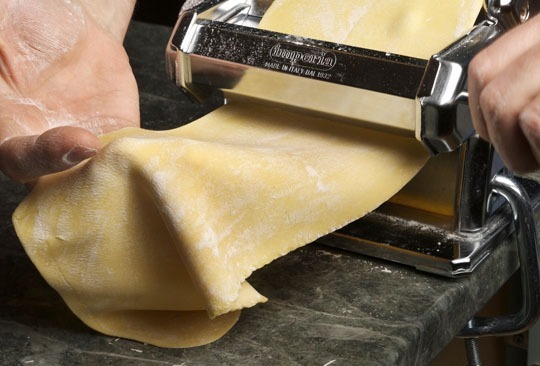
Part of the pleasure of making pasta at home is the feel of the dough.
Photo by Donna Turner Ruhlman.
Pasta Dough
9 ounces/255 grams all-purpose flour (about 2 cups)
3 eggs
Combine the flour and eggs in a bowl and mix them with your fingers to combine.
When the dough comes together, knead it on a floured board or countertop, pressing it with the heel of your hand, folding it over, kneading, folding until it is velvety smooth. This will take 5 to 10 minutes.
Form the dough into a disk. Put a towel or plastic wrap over the dough and let it rest on the counter for 20 to 60 minutes. The dough can also be refrigerated for up to 24 hours.
Cut the dough into 4 equal pieces, roll them into the desired thinness and cut as you wish. You can cut your noodles using a pasta machine or with a knife.
Other links you may like:
My past rants on Bacteria! Run Away! Run Away! and Cook Your Own Food.
ServSafe from the National Restaurant Association certifies people to handle food in a restaurant setting.
What happens when a food writer can’t taste.
© 2014 Michael Ruhlman. Photo © 2014Donna Turner Ruhlman. All rights reserved.
January 6, 2014
New Year’s Goals (and How to Make Soap)
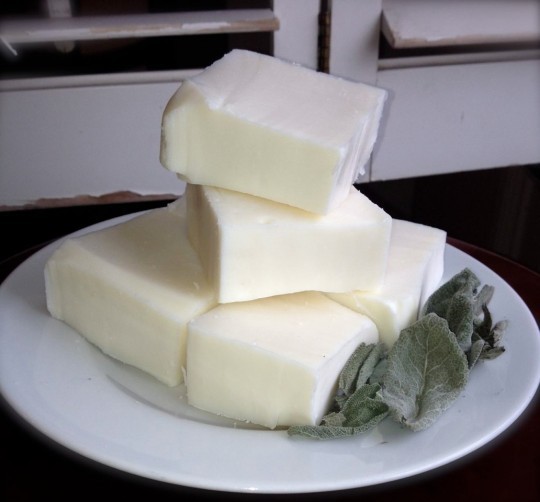
Soap made from scratch. Photo by my iPhone.
How this workaholic longs for the holidays to be over! Especially when the big days fall midweek, effectively knocking out two full weeks. I tried not working—reading, watching movies—but that just resulted in flatness. I need to work, writing or cooking, apparently the way a shark needs to swim.
This week is time to think ahead toward what I hope to accomplish in 2014. I’ve already achieved one goal, small though it was. A few friends and I bought and broke down a pig in December (will post about this soon) and it was exceptionally fatty, leaving us with far more rendered lard than I need to cook with. How to use all this fat? Make soap. To my amazement, it was a breeze and finished in 30 minutes. Though there’s relatively little on the internet, this site provided ratios! Hard to know who this source is, but the ratio worked like a dream, considerably less water than other internet recipes.
This was really important to me because part of my goal was to waste as little of the pig as possible, and this is a lovely neutral soap that leaves the skin feeling moisturized after using.
Other goals for 2014:
A redesign of this site. I’ve wanted a proper logo, a cleaner look, and a regular partner (the wonderful company Le Creuset so that I don’t have those annoying ads for Kraft Ranch Dressing popping up on a homemade mayo post!). And most important a responsive site that adjusts to the varying screen sizes we use.
A new and improved Ratio app for the new iPhone, with a new design and a fabulous new feature that will allow users to create their own ratios! Very excited about this.
HBI, a scale company I love, is making a scale to my specifications, one that I can recommend to all home cooks.
My innovative (not an idle claim, it truly is innovative) look at the world’s most versatile culinary ingredient, will be published in April by Little, Brown, and I am at work on four short, single-subject books on specific techniques, as that is what all cooking comes down to, fundamental technique. The first, Roast, will appear next fall.
I’m working with a talented small group, one an accomplished writer-director, on a scripted drama for cable, a drama set primarily at a cooking school and a Manhattan restaurant. We have been working on this FOREVER, I am determined to get this off the ground this year.
I’m hoping to do a newsy food-related show that I want to call “Wake the Fuck Up!”—but I don’t know if this is going to fly; wish me luck.
I’m hoping very much to publish two non-food stories, a novella and a short novel—to publish fiction, my earliest adult goal, has eluded me.
I want to create an electronic book of cocktails, based on my Friday Cocktail Hour posts, since those have been so popular, and I’d love to have them in a single source, organized and easily searched.
I want to broaden the Ruhlman cooking tools, make new ones and sell more so that we can lower the damn prices and start shipping to Canada and beyond.
And I look forward to reintroducing the Schmaltz app for iPads, with additional recipes. Maybe one for schmaltz soap!
As 2014 begins I’d like thank all those people who join me and help me in my work: my assistant Emilia Juocys; copyeditor Karen Wise; Little, Brown editor Michael Sand; David and Joleen Hughes of Level Design; Stephen Jenkins, the man behind my website; Ann and Richard Lagravenese and Robin Skye; Will Turnage; Laura Yorke; Lisa, Cait, Adam, Vanessa, and so many others at CAA; Will Copenhaver at Le Creuset, David Mulvaney (the scale); April Clark (the Schmaltz app); Mac Dalton (our tools); and last and most important by far, my wonderful wife, Donna, without whom I couldn’t do half of this.
Now, about the above soap, comments and, especially, questions for people who actually know something about this.
For instance, I’m told that it needs to cure, presumably to get the rest of the water out. But the soap above is lovely and useable as is, 24 hours after making it. I intend to wrap and freeze some now (my only concern is rancidity), let some cure, and use some daily. Can anyone advise about the purpose of curing?
I steeped dried sage leaves from the garden in the oil then strained them out because I feared too piggy a smell, but there’s little sage scent and little smell; it’s actually a lovely, clean, neutral-smelling soap and leaves the hands feeling soft. I’m told you can add essential oils for fragrance, but I really like this unscented, no-nonsense version.
Again, I used straight rendered pig fat, lye, and water, nothing else. Worked like a charm. Here’s a source for food-grade lye (don’t be afraid of it, just be careful; I don’t use gloves or goggles and I’m fine). When you aren’t using it for soap, use it to make great pretzels or cure olives!
Lard Soap Ratio:
100% rendered lard
13% lye
38% water
I used:
600 grams lard
78 grams lye
228 grams water
Line a small baking dish or loaf pan with parchment paper.
In a medium, high-sided sauce pan, heat the fat to a temperature of 115˚F/46˚C., give or take a few degrees.
In a separate pan, bring the lye and the water, stirring to dissolve the lye crystals, to the same temperature. Pour the lye water into the fat. Using a hand blender, blend this mixture until it looks like a custard sauce, so that a ribbon will remain distinct on top before becoming one with the mixture again (this is called tracing). It took me 20 minutes. I stopped every now and then to let the motor cool. For some people it can take 30 minutes. Just be patient, and be sure the mixture doesn’t go below 110˚F/43˚C or, for that matter, above 120˚F/49˚C.
Pour the soap into the parchment-lined pan; again, it had the consistency of a lemon custard, and it began to set up immediately, so don’t dally here. Press a layer of parchment on top of this. Allow to set up for 24 hours. It should be hard by this point.
Remove from the mold and cut as desired (I used a wire cheese cutter). I’ve read you’re supposed to let it cure for 3 to 4 weeks in a cool dry dark space. Evaluate it now—it may be good to go. I think because I used less water than most recipes called for it hit the trace stage fairly quickly and is ready for use today.
Other links you may like:
I don’t own soap-making books, but you might have a look at these: Making Soap from Scratch and Soap Maker’s Workshop.
For good DIY projects check out Punk Domestics.
Make homemade soap with Tierra Soul, otherwise known as the Arias family.
© 2014 Michael Ruhlman. Photo © 2014Donna Turner Ruhlman. All rights reserved.
December 31, 2013
Happy New Year (Top Posts of 2013)

Santa, emblem of the infinite giver/photo by Donna
As the holidays wind down and before we look forward toward 2014, I’m looking back on a few of the more popular posts of the year. One of the most trafficked was inspire by a report, picked up at face value by all the media it seems, that urged people not to wash their chicken because it sprayed bacteria all over the place. The ever sensible and funny Alton Brown, tweeted a post-it commentary that inspired this: Bacteria! RUN AWAY! RUN AWAY! America’s ridiculous and idiotic fear of bacteria.
Of course, we all want to be happy and healthy. Here’s my advice: Cook Your Own Food. Eat What You Want. (Think for Yourself.) The irony of it is that I don’t think you should follow it, as I explain in the post.
And more ranting on the general state of the ways of this country: America Has a Serious Eating Disorder
Final Word on Battle of the Spoons (with Crème Anglaise)—spoons, one of my favorite subject (and Le Bernardin’s recipe for vanilla sauce).
Wheat Berry Salad—this is a great recipe, but it was clicked on a lot because it was my attempt to go vegan as weight-loss strategy (a notion many people disabused me of, noting you can get plenty fat eating pasta; paleo was the way to go for losing weight). Wasn’t as hard as I thought it was going to be!
American biscuits are unique and subject to controversy. Some prefer drop, I prefer flakey and buttery: The Key to Flaky Biscuits.
This bears repeating: Home Cooks’ Biggest Disadvantage
And finally, my take on a fuss I’m not sure is all that important, though many feel otherwise. Are Tasting Menus the Way Toward “Art”?
Thank you all for reading and for your thoughtful comments. Look for a revised look to this site early in the new year.
All best wishes to you and your family for a peaceful and prosperous 2014!
© 2013 Michael Ruhlman. Photo © 2013 Donna Turner Ruhlman. All rights reserved.
December 25, 2013
Happy Holidays To All

Photo by my beloved Donna
And best wishes to you for a happy and fruitful new year with lots of home cooked meals!
See you in the new year!
December 21, 2013
Holiday Cookies

An array of christmas cookies just waiting for folks to nibble on them. Photo by Emilia Juocys.
Every year in about September I start thinking about what cookies I want to bake for Michael’s blog. Its starts off as a long list and then gets cut down, so a variety of cookies are presented, ranging from classics to new formulations. This year I wanted to share two new recipes: a Cardamom Ginger Coconut cookie, inspired by my love of Indian food, and a gluten-free Linzer cookie. After spending time with a teammate who is gluten intolerant I decided to make a cookie just for her.
The cardamom ginger coconut cookie has a soft spot in my heart because it marries the incredible base dough of my chocolate chips cookies and Indian cuisine. This cookie warms you with aromatics, cardamom and coriander. You get extra warmth from the minced crystalized ginger. There may be a lot of ingredients, but I am sure this is a cookie that will put a smile on anyone’s face this holiday. It did for my sister. She was very skeptical of this recipe; after they came out of the oven she did a 180 and loved these little nuggets.
Gluten-free linzer cookies are simple for those who, like me, who are new to gluten-free baking. I have been practicing because it is a bit different then traditional baking, using special flours, blends, or thickening agents. I am glad to report that I have been getting better. So for this holiday I wanted to share a fun and easy cookie based off of an old classic. What I love about this cookie is the hazelnut flour, its rich nuttiness that is enhanced by adding some cinnamon, and the raspberry preserves that makes it the signature linzer cookie profile. Great for all nibblers—even those who are not gluten free—a no-complaint cookie.
Cookie baking for me is both fun and therapeutic. I enjoy the sounds of the mixer paddling the sugar and butter, the wonderful aromas of spices traveling though the house. There is no place I would rather be than in my kitchen baking multitudes of cookies for my loved ones as music blares in the background, having my own kitchen rave. Baking makes me happy and makes others smile around me. Home is where the cookie hearth is—along with a cup of milky hot coffee.
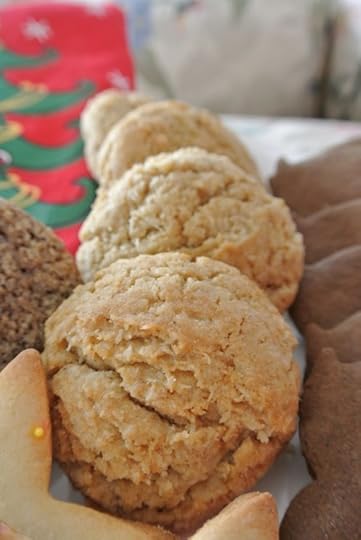
Cardamon Ginger Coconut Cookies
Cardamom Ginger Coconut Cookies
1 cup cake flour
3/4 cup bread flour
3/4 teaspoon salt
3/4 teaspoon baking powder
1/2 teaspoon plus 1/8 teaspoon baking soda
3/4 cup unsalted butter, at room temperature
1/2 cup granulated sugar
1/2 cup brown sugar
1 1/2 teaspoons ground cardamom
1/2 teaspoon ground coriander
1/8 teaspoon ground cinnamon
1 large egg
1 teaspoon pure vanilla extract
2 tablespoons minced crystalized ginger
3/4 cup shredded coconut
Sift together the two flours, salt, baking powder, and baking soda. Set aside.
In a standing 5-quart mixer with the paddle attachment, begin to cream together the butter, the two sugars, and the three dry spices. Paddle on medium-high speed until light and fluffy, about 5 minutes.
Add in the egg and vanilla and paddle until incorporated. Scrape down the sides of the bowl with a rubber spatula. Paddle on low and add the minced ginger . Pour in the dry ingredients on low speed and then the coconut.
Once the dough has come together, let it rest for 5 hours to overnight. When ready to bake, preheat the oven to 350°F/177°C. Scoop out tablespoon-size cookies onto a sheet tray lined with parchment paper or a Silpat. Bake until done, 10 to 12 minutes. Remove from the oven and allow to cool.
Makes 28 cookies
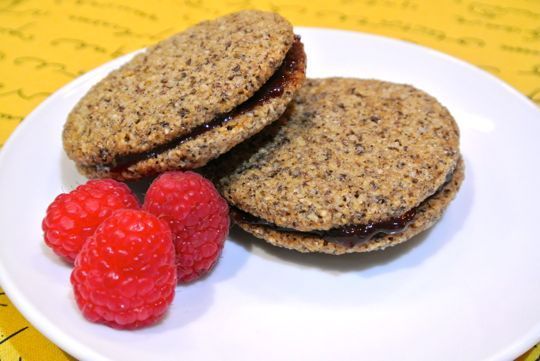
Gluten free linzer cookies
Gluten-Free Linzer Cookies
3 cups hazelnut flour
3/4 teaspoon salt
1/2 teaspoon baking soda
1/2 cup unsalted butter, at room temperature
1/4 cup shortening
1/2 cup granulated sugar
1/4 brown sugar
1 1/2 teaspoons ground cinnamon
2 teaspoons pure vanilla extract
2 large eggs
Raspberry preserves, as needed
Preheat the oven to 350°F/177°C.
Sift together the hazelnut flour, salt, and baking soda. Set aside.
In a standing 5-quart mixer with the paddle attachment, begin to cream together the butter, shortening, the two sugars, and the cinnamon. Paddle on medium-high speed until light and fluffy, about 5 minutes.
Add in the eggs and paddle until incorporated. Scrape down the sides of the bowl with a rubber spatula. Pour in the dry ingredients on low speed.
When ready to bake, scoop out teaspoon-sized cookies onto a sheet tray lined with parchment paper or a Silpat. Bake until done, 11 to 13 minutes. Remove from the oven and allow to cool.
Spread a thin layer of raspberry preserves and sandwich two cookies together.
Makes 24 sandwiches or 48 cookies
Other links you may like:
Michael’s snickerdoodle recipe from Twenty.
Emilia’s cookie recipes from 2012 and from 2011.
Learn to bake and assemble a Swedish gingerbread house from Martha Stewart.
A great cookie app called Cookulus.
© 2013 Michael Ruhlman. Photo © 2013Donna Turner Ruhlman. All rights reserved.
December 20, 2013
Cocktail Hour Reprise: The Major Award
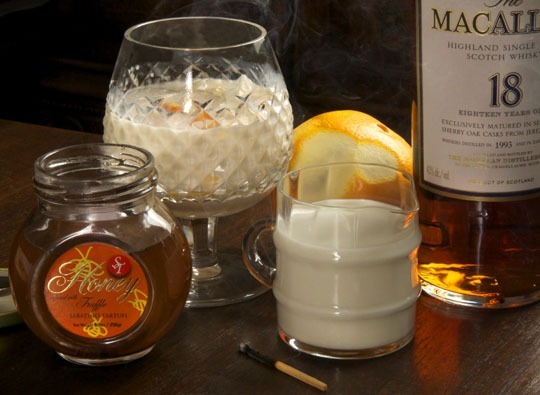
The Major Award/Photo by Donna Turner Ruhlman
Last year, Claudia Young created this truffle-infused cocktail for The Velvet Tango Room, Paulius Nasvytis’s well-known Cleveland bar. It’s today’s choice for the Friday Cocktail Hour because it is the very embodiment of the holidays: rich, fragrant, expensive, delicious. I loved milk punch when a friend introduced me to that simple concoction—bourbon, milk and sugar. This is a milk punch times ten—a decadent but simple combo of Scotch, truffled honey, and half-and-half.
This Cleveland original (), was named by a Clevelander for a movie filmed here, a movie about Christmas. What more appropriate drink could there be as Christmas approaches for today’s Hour?
The Major Award
To serve 1:
1.5 ounces Oban (or other single-malt whiskey)
1 ounce truffle honey syrup made with a 1:1 water to honey ratio
1 ounce half-and-half
1 slice of orange zest for flaming
Mix liquids.
Pour over ice.
Flame the zest: ready the peel over the glass, hold a lighted match close to the peel, moving the flame up and down to draw the oil out, then pinch the peel so that the oils pass through the flame and onto the drink.
Other links you may like:
My past holiday cocktail posts: Eggnog and Holiday Glogg.
The best bar in the world, aka the Velvet Tango Room.
Learn about the regions of Scotch in Scotland.
Here are five essential Scotch cocktails from Serious Eats.
© 2013 Michael Ruhlman. Photo © 2013 Donna Turner Ruhlman. All rights reserved.
December 18, 2013
Holiday Giving: “The More That I Give…”
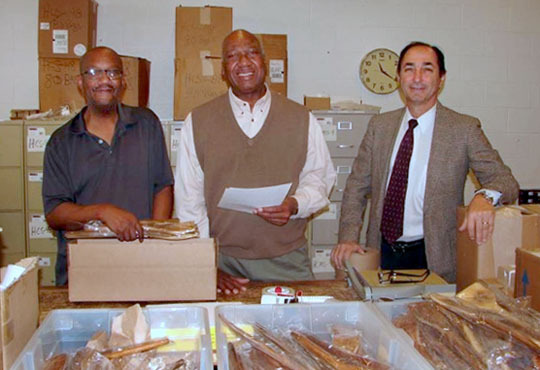
From left: Donald Jackson, Ernest Tubbs, and Tavi Gargano, of Vocational Guidance Services, in Cleveland, OH/Photo courtesy VGS.
My partner in kitchen tools, Mac Dalton, and I have for years relied on a local Cleveland nonprofit, Vocational Guidance Services (VGS), to ship our tools. VGS has for decades employed those who can’t otherwise find work—the disabled, people who have been homeless, people who are recently out of jail. In other words, VGS is a valuable part of our community and Mac and I put a strain on them with our recent sales, so I want to thank them publicly for their good work. Ottavio Gargano, along with Bernie Nenadovich and Ernie Tubbs, and especially all the good people who fulfill our orders, thank you for your work. You make my beloved city of Cleveland a better place.
“The More That I Give, the More That I Have”: Where to Donate During the Holidays (and ever after)
Thinking about VGS makes me think about ways I can do more to give back as a way of saying thanks for my good fortune. Because I make my living in the food world, I give to hunger relief programs. Two programs that are highly recommended are The Hunger Project, for global hunger relief, and One Acre Fund, which focuses specifically on farmers in Africa. Click on the links and see if what they do is meaningful to you. If it is, send some love.
These were recommended to me by Charlie Bresler, who runs The Life You Can Save, founded by Peter Singer, a writer-philosopher I admire (despite the vegan business). It’s a foundation that wants to eradicate world poverty and the unnecessary pain and death that results from it. But it’s also an organization that simply asks that more of us who live comfortably recognize that giving is part of living ethically, as much a part of living an ethical life as is not lying and stealing, or helping your neighbor or a stranger in need, or working to strengthen your immediate community. (Watch Stephen Colbert grapple with Singer’s suggestions.)
If giving isn’t already something you regularly do, Singer asks that you give just 1% of your income—preferably more, but let’s just get started with that tiny 1%, he says.
To donate to your local community, do some research. Here in Cleveland, you can donate to The Hunger Network, working to reduce hunger in Greater Cleveland. To donate to our Vocational Guidance Services, click here. I asked Mario Batali who he’d recommend. He said the Food Food Bank for New York City, and also his own hunger prevention efforts, The Mario Batali Foundation. Mark Maynard-Parisi, of Blue Smoke in NYC, says that his company, Union Square Hospitality Group, actively supports, among others, City Harvest locally, and Share Our Strength, a national hunger-prevention organization focusing on making sure kids get enough to eat.
Non-food-related gifts: Give gifts on behalf of people you love. At the recommendation of New York Times reporter and op-ed columnist, Nicholas Kristof, I’m giving to the Afghan Institute of Learning for its work in educating women, which will surely do more to help that country than bombs. He also recommends the Carrera Adolescent Pregnancy Prevention program, New York–based and spreading to many other states, which recognizes that pregnancy prevention is a fundamental link in cutting cycles of poverty, and noting that you can, for $50, help fund a student’s college education as part of its financial literacy component.
The words in bold above are of course from Romeo and Juliet, Juliet’s remark on her love for Romeo: “The more I give to thee, the more I have….” As this is a holiday that for me, is about the celebration of love and of peace, these are words to remember, for they are true of all that we give.
Happy Holidays to all.
Michael Ruhlman's Blog
- Michael Ruhlman's profile
- 354 followers



